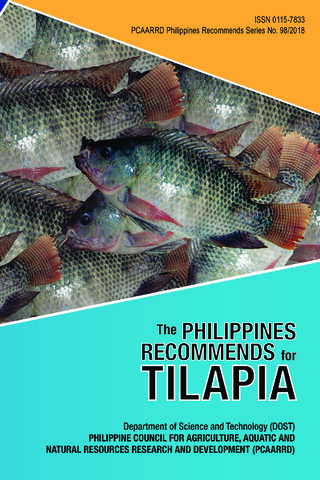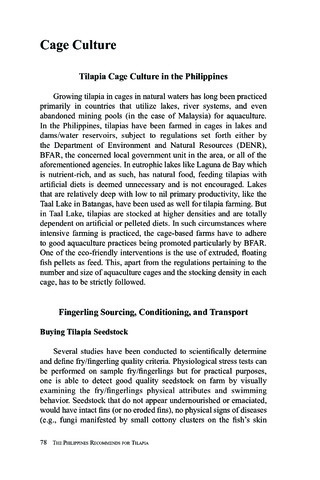Perlihatkan publikasi sederhana
Effect of shrimp biomass and feeding on the anti-Vibrio harveyi activity of Tilapia sp. in a simulated shrimp–tilapia polyculture system
| dc.contributor.author | Tendencia, Eleonor | |
| dc.contributor.author | dela Peña, Milagros R. | |
| dc.contributor.author | Choresca, Casiano H., Jr. | |
| dc.date.accessioned | 2014-05-15T01:42:32Z | |
| dc.date.available | 2014-05-15T01:42:32Z | |
| dc.date.issued | 2006 | |
| dc.identifier.citation | Tendencia, E. A., dela Peña, M. R., & Choresca Jr., C. H. (2006). Effect of shrimp biomass and feeding on the anti-Vibrio harveyi activity of Tilapia sp. in a simulated shrimp–tilapia polyculture system. Aquaculture, 253(1-4), 154-162. | en |
| dc.identifier.issn | 0044-8486 | |
| dc.identifier.uri | http://hdl.handle.net/10862/2051 | |
| dc.description.abstract | The efficiency of Tilapia hornorum to control luminous bacteria in a simulated shrimp farm environment has been reported. However, the effects of different factors such as feed input and the shrimp biomass were not taken into consideration. This study investigated the effect of feeding and increased shrimp biomass on the efficiency of tilapia to inhibit the growth of luminous bacteria. Results showed that feeding enhances the antibacterial activity or improves the efficiency of tilapia to inhibit the growth of luminous bacteria. However, the efficiency of tilapia at a biomass of 500 g/m3 is reduced if the shrimp biomass is greater than 80 g/m3. This explains the discrepancies in the results obtained in the use of tilapia to control luminous bacterial disease in shrimp ponds. The effect of starvation on the bacterial load of tilapia, grouper and milkfish feces and the amount of feces in the intestine was also investigated. Results showed that total bacterial and presumptive Vibrio count of fish feces decreased after 1 week of starvation except for the presumptive Vibrio count of grouper. The amount of feces in the intestine also decreased as starvation progressed. Moreover, bacteria isolated from the three species have antibacterial activity against the luminous bacteria Vibrio harveyi. | en |
| dc.description.sponsorship | The authors wish to thank the Government of Japan for funding the study under the trust fund granted to SEAFDEC AQD (study code: 6251-300-60); and SEAFDEC AQD under study code FH 07 C2001T. | en |
| dc.language.iso | en | en |
| dc.publisher | Elsevier | en |
| dc.subject | Luminous bacteria | en |
| dc.subject | tilapia | en |
| dc.title | Effect of shrimp biomass and feeding on the anti-Vibrio harveyi activity of Tilapia sp. in a simulated shrimp–tilapia polyculture system | en |
| dc.type | Article | en |
| dc.identifier.doi | 10.1016/j.aquaculture.2005.08.004 | |
| dc.citation.volume | 253 | |
| dc.citation.issue | 1-4 | |
| dc.citation.spage | 154 | |
| dc.citation.epage | 162 | |
| dc.citation.journalTitle | Aquaculture | en |
| seafdecaqd.library.callnumber | VF SJ 0802 | |
| seafdecaqd.databank.controlnumber | 2006-03 | |
| dc.subject.asfa | aquaculture development | en |
| dc.subject.asfa | bacterial diseases | en |
| dc.subject.asfa | biomass | en |
| dc.subject.asfa | disease control | en |
| dc.subject.asfa | feeding behaviour | en |
| dc.subject.asfa | fish culture | en |
| dc.subject.asfa | fish diseases | en |
| dc.subject.asfa | freshwater crustaceans | en |
| dc.subject.asfa | freshwater fishes | en |
| dc.subject.asfa | intestines | en |
| dc.subject.asfa | polyculture (aquaculture) | en |
| dc.subject.asfa | shrimp culture | en |
| dc.subject.asfa | feeding | en |
| dc.subject.scientificName | Tilapia hornorum | en |
| dc.subject.scientificName | Vibrio harveyi | en |
Files in this item
| Files | Size | Format | View |
|---|---|---|---|
|
There are no files associated with this item. |
|||
Publikasi ini ada di koleksi berikut
-
Journal Articles [1258]
These papers were contributed by Department staff to various national and international journals.




